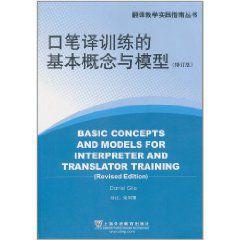內容簡介
法國巴黎新索邦大學(第三大學)高級翻譯學院教授,長期從事專業口筆譯工作及相關教學與研究,成績斐然,是國際筆譯界公認的專家。
作者簡介
作者:(法國)吉爾(Daniel Gile) 合著者:柴明熲
圖書目錄
CHAPTERl. Theoretical components in interpreter andtranslatortraining i
1.The role of training ininterpreting and translation1
2.The components of Translation competence4
3.The diversity oftraining requirements6
3.1 In.itial trainingprogrammes for newcomers to Translation6
3,2 Conversioncourses/further training/continuingeducation forpracticing Translators7
4.The need for optimization in formal Translator training8
5.The process-oriented approachin Translator training10
6.Potential benefits of theoretical components in interpreter and translator training
7.Potenhal criteria and rules for theoretical components for training13
8.Where and how to find theoretical components for Translator training 15
9.The models17
10. This chapter's mainideas18
CHAPTER2.Communication and quality in interpreting andtranslation 20
1. Introduction 20
2.ProfessionalTranslation: An act of communication21
2.1 Non-professional Translation21
2.2The Actors'configuration in professional Translation22
2.3Awareness of Translation and its effects23
3.Aims and intenhons24
3.1Fundamental aims and intentions24
3.2Macro-Ievel and micro-level aims25
3.3The communication actors'aims and professional loyalty26
3.3.1Convergence and divergence of aims26
3.3.2 Professional loyalty27
4.Content and Packaging30
5.Quality 31
5.1The criteria31
5.2Discourseand qualitycomponents32
5.3The perception of quality: positions33
5.4The perception of quality: motivation and attention37
5.5Behavioural components of quality38
6.Socialstatus and quality39
7.Teaching suggestions40
8.What students need to remember42
APPENDIX-A demonstrahon in the classroom for written translation43
CHAPTER3.Fidelityininterpretingandtranslation 46
1.Introduction 46
2. Anexperimentinfidelity 48
2.1Phase one: verbalizing a simple idea48
2.1.1 Framing Information51
2.1.2 Linguistically/Culturally Induced Inforrrmtion52
2.1.3 Personal Information52
2.2Phase two, version1:translating a simple statement53
2.3Phase two, version2:immediate replication55
3. Principlesoffidelity 55
3.The Message56
3.2 Framing Information57
3.3 Linguistically/Culturallylnducedlnformation 58
3.4 Personal Information59
3.5 Conclusion 59
4.3econdary Information: an obstacle and a help62
4.1 Thelanguage-specificity of LCII-generatedproblems62
4.2Interpreting us.translation from the Secondary In:formation perspective63
……
5.Teaching suggestions65
5.1 Theexperiment 65
5.2 A road-map metaphor66

